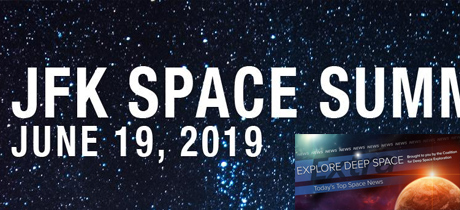In Today’s Deep Space Extra… The cost and schedule of Artemis, the White House directive that NASA return to the surface of the Moon with human explorers by 2024, continues to draw scrutiny. John F Kennedy Presidential Library “Space Summit” begins at 9:00 am with an address by Boeing CEO Dennis Muilenberg. Launched a decade ago, NASA’s Lunar Reconnaissance Orbiter (LRO) is proving a valuable resource for establishing an exploration agenda.
Human Space Exploration
Government watchdog says cost of NASA rocket continues to rise, a threat to Trump’s Moon mission
Washington Post (6/18): NASA continues to face cost increases with the development of the Space Launch System (SLS), a critical component of Artemis, the White House directive to return human explorers to the surface of the Moon in 2024. The Post story, which is based on an advanced look at an audit report expected to be released Wednesday, says Artemis 1, the uncrewed first test flight of the SLS may slip to June 2021. The auditors also expressed concern for the cost of developing the Orion crew capsule.
JFK Space Summit
The John F Kennedy Presidential Library is livestreaming an all-day event in anticipation of the 50th Anniversary of Apollo 11, featuring Boeing CEO Dennis Muilenberg, former NASA Administrator Charles Bolden, Smithsonian Air and Space Museum Executive Director Ellen Stofan, NASA astronauts and Jeff Bezos in a conversation with Caroline Kennedy. Livestream begins at 9:00 am ET this morning.
Astrobotic awarded NASA study contract for polar mission to the Moon
Coalition Member in the News – Astrobotic
Astrobotic (6/18): The company is elaborating on its selection by NASA to launch and land science payloads at the Moon’s south pole. A study contract awarded Astrobotic by NASA will analyze how the company’s medium lunar lander, Griffin, and its rover, Polaris, could deliver volatile-detecting payloads to the lunar south pole. Water ice is among those volatiles. The mission would also pave the way for NASA’s human lander mission in 2024, the first since the end of the Apollo program, by surveying the landing site.
Space Science
NASA’s Lunar Reconnaissance Orbiter (LRO) turns 10, with lessons for Moon missions
Space.com (6/18): Launched a decade ago this month, NASA’s Lunar Reconnaissance Orbiter (LRO) is proving itself a valuable resource as NASA plans for an accelerated return to the surface of the Moon with human explorers in 2024. So far, LRO has identified ice deposits at the south pole and helped to map the cratered landscape in greater detail.
NASA ramps up search for alien planets, may use huge ‘star shade’
Fox News (6/18): NASA’s Jet Propulsion Laboratory (JPL) is making strides with development of a star shade technology, a technology that when combined with a powerful space telescope would permit vastly improved observations of distant stars and their planets. Launched with a future observatory, the star shade would separate and align with the telescope to block the bright light from a star, allowing the telescope an enhanced view of the surrounding region.
Planetary orbits may explain mystery of sun’s 11-year cycle
Space.com (6/18): The sun observes an 11 yearlong activity cycle, rising from low to high and returning to low with the output of energetic flares and coronal mass ejections that can pose a threat to satellites in Earth orbit, terrestrial power grids and humans, especially to astronauts traveling beyond the protection of the Earth’s magnetic field. A German led study suggests the orbits of Venus, the Earth and Jupiter may explain the rhythm of the solar cycle.
Neptune is a windy, chilly, and baffling planet. Let’s go!
Wired (6/17): NASA’s still traveling Voyager 2 spacecraft soared within 3,000 miles of distant Neptune on August 25, 1989 providing the first close-up view of a still intriguing possible future destination, plus the eruptive moon Triton and four lumpy rings. Now, it’s believed that the ice giants Uranus and Neptune may perhaps represent the most common kind of planets in the Milky Way.
Other News
Executive order could reduce number of NASA advisory committees
SpaceNews.com (6/18): NASA is among federal agencies directed on June 14 to assess the need for advisory committees and inform the Office of Management and Budget (OMB) of their findings by August 1. The dozen panels that advise NASA include the NASA Advisory Council and the Aerospace Safety Advisory Panel. The OMB will have a month to forward its recommendations to the White House.
NASA concept for generating power in deep space a little KRUSTY
Spaceflightinsider.com (6/18): KRUSTY is the nickname for a joint NASA/Department of Energy effort to develop a deep space nuclear power source for planetary surfaces. KRUSTY stands for Kilopower Reactor Using Stirling Technology. Lightweight and compact, KRUSTY could generate up to 10 Kilowatts of power on the surface of the Moon or Mars.
Apollo 11
Apollo astronauts celebrate 50 years since first Moon landing
Reuters via New York Times (6/18): The Paris Air Show welcomed NASA Apollo 7, 15 and 16 astronauts Walt Cunningham, 87; Al Worden, 87; and Charlie Duke, 83, on Tuesday. All were present to celebrate the approaching 50th anniversary of Apollo 11, the first time humans landed on the Moon, July 20, 1969.
The hard-charging space program: Breakthroughs, breakups and breakneck
Washington Post (6/19): What was 1969, the year Apollo 11 and its crew carried out the first lunar landing on July 20, 1969 like? Hectic in more ways than one.

